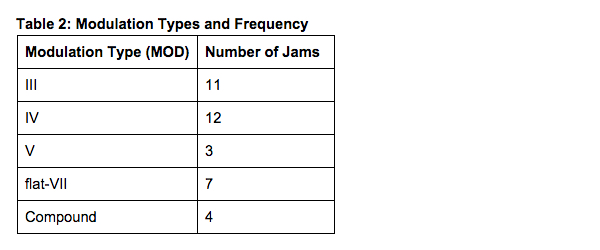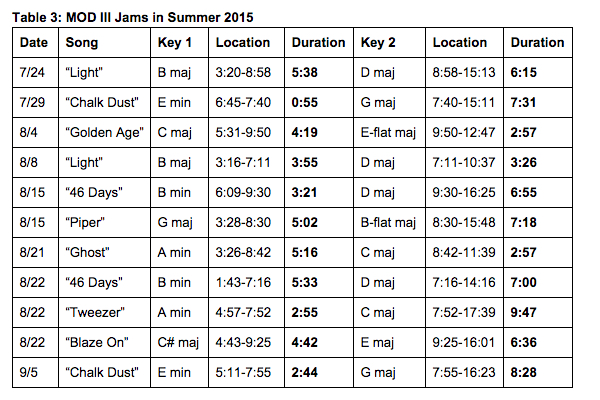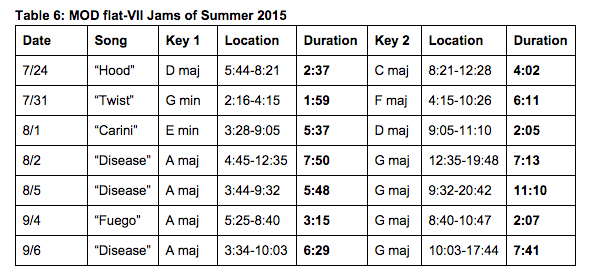BLOG POSTS WHERE MONTH IS 9, AND DAY IS 28, AND YEAR IS 2015
MODULATING JAMS OF SUMMER 2015 - PART 2
[Editor's Note: We welcome back phish.net contributor and musicologist Mike Hamad, who shares his thoughts on the "Modulating Jams of Summer 2015." Below is the second of three parts. If you missed it, you may wish to start with part one. Part three will run tomorrow. -PZ]
PART TWO
Modulation Types & Pathways
The 37 modulating jams of summer 2015 fall into five categories. I’ll discuss these in turn, along with common pathways (and exceptions) for getting from point A to point B (and sometimes, to point C). These five categories, and the number of jams they contain, are included in Table 2:

MOD III: The Light is Growing Brighter
Tonal music is based on the diatonic scale, in which two “tonics” (hence “dia-tonic”) – one major and one minor – compete for primacy. As a result, the keys built around those each tonic (B minor and D major, for example) are known as “relatives”; D is the relative major of B, and B is the relative minor of D. This extends enharmonically to any other set of relatives: A min/C maj, E min/G maj, and so on. Relatives share a key signature (two sharps, in the case of B/D) and the majority of their pitches (chromatic pitches, such as G# and A#, are brought in to tonicize B minor, but that’s not important here.)
In B minor, or any key, the chord built on the third degree of the scale (i.e. D major) is known as the mediant. MOD III jams, then, modulate from the tonic key (i.e. B) to the key located a minor third (three half-steps up on the piano keyboard) above it (i.e. D major).
MOD IIIs are close, easy modulations (there’s no change in location on the circle of fifths); the bassist simply chooses D, which already exists as part of the B minor scale, and makes it “home.” The other players simply buy-in with D major melodies and triads.
MOD III moves always progress from minor to major, and therefore they’re filled with a sense of light overcoming darkness, happiness defeating sadness, a feeling of bliss, and so on. MOD III moves, furthermore, frequently happen at a low point in the dynamic trajectory of a jam (in my schematics, I label these “DYN DIP”). The band often rests in the new key while figuring out what to do next.
"Twist" > "Light" – 7/24/15, Mountain View, CA
Table 3 shows the eleven MOD III jams Phish played this summer, including how long they spent in each key:

Pathways: MOD III jams that start in minor keys (“Chalk Dust,” “46 Days,” “Ghost,” “Tweezer”) simply flip over to the other tonic:
E min > G maj (“CDT”)
B min > D maj (“46 Days”)
A min > C maj (“Tweezer,” “Ghost”)
MOD III jams that begin in a major key (“Light,” “Golden Age,” “Piper,” “Blaze On”), however, require a little more work. In every case this summer, major-key jams flipped to the minor mode in the same key (what’s known as “mode-mixture”) before each move was made:
B maj > min > D maj (“Light”)
C# maj > min > E maj (“Blaze On”)
G maj > min > B-flat maj (“Piper”)
C maj > min > E-flat maj (“Golden Age”)
Why?
A minor and C major are relatives; they share tons of pitches. Moving from one to the other isn’t dramatic. A major (three sharps) and C major (no sharps), however, actually are sort of distantly removed from each other; going from one to the other, without preparation, is jarring (although the majority of Abbey Road is built on this very relationship).
Some interesting things happened in MOD III jams. The 8/4 “Golden Age” contains a transposed version of its signature bridge progression (“Love, don’t you falter,” or I-IV) into the new key (E-flat major). We heard the “Tweezer” riff in B-flat at the end of the 8/15 “Piper.” After three minutes of jamming in C major, the 8/22 “Ghost” segued into “Rock and Roll” (more on this later).
MOD IV: The High Gear of Your Soul
In any key, scale degree ^4, unlike ^3 or ^5, is a dissonance. And dissonance – in life and in music – usually leads to rapid change.
The chord built on the fourth scale degree, or IV, is often referred to as the subdominant. MOD IV jams modulate from the tonic (home) key (C major, for example) to the major chord built upon the fourth degree of the scale (five half-steps up on the piano keyboard, or F major). This represents a shift one step to the flat-side on the circle of fifths.
Like MOD IIIs, MOD IVs can either mean settling into a blissful resting place (the move from C maj > F maj in the Tahoe Tweezer comes to mind). More often, however, MOD IVs are immediate infusions of energy (as in the 8/22 “Caspian”). There’s occasionally some settling in once MOD IVs arrive, but often not much.
Table 4 lists the twelve MOD IV jams Phish played this summer, including how long they spent in each key:

Pathways: typically, MOD IVs don’t require a pathway. Mode-mixture is unnecessary. One member of the band simply bangs on the fourth scale degree. Because it’s dissonant, the others react pretty quickly. The destinations, at least in 2015, are always major keys (not minor iv).
(Quick aside: “Simple” jams usually begin with band members repeating a I-IV (F to B-flat) chord progression in F major. At 7:18 of the 8/21 “Simple” jam, they spontaneously decide to stop on the B-flat and quit alternating back to F.)
MOD V: Plugging the Distress Tube
The chord built on the fifth scale degree is known as the dominant. In tonal music, the dominant is the least stable place to be; the built-in tension resolves only with the return to the tonic (I) or a move to some other place (VI, or what’s called a deceptive cadence). In the Phish repertoire, “Steam” and “Maze” (each in G minor) are good examples of songs that have extensive jams in the dominant key (D maj/min). We all have felt how tense those jams are, for this and other reasons. When G minor returns in each case, at the end of the jams, it’s a relief.
None of that matters much here; modulations to the dominant key (seven half-steps up or five half-steps down on the piano keyboard), or MOD V, are less common than the other types, and they generally don’t feel all that tense.
Table 5 lists the three MOD V jams Phish played this summer, including how long they spent in each key:

Pathways: each of the three MOD Vs of summer 2015 preserves the mode of its starting key: 7/31 “KDF” moves from C min > G min; 8/7 “Tweezer” moves from A min > E min; 8/22 “Light” moves from B maj > F# maj. The MOD V in the 7/31 “KDF,” one of the longest jams of the summer, feels arbitrary; so does the move to F# maj midway through the Magnaball “Light” (8/22), but at least it demonstrates “Light” can do more than just MOD III.
The 8/7 “Tweezer” is notable because of what happens earlier: “Chalk Dust Torture,” a MOD IV (E min > A maj), gives us a long taste of A-ness long before “Tweezer” arrives. The MOD V “return” back to E min in “Tweezer,” then, feels like a return to the “Chalk Dust” jam. If you reduce the Blossom “CDT” -> “Tweezer” down to keys and modes, it looks like this: E min > A maj/min > E min (or I - IV - I). More than any other pairing of the summer (except, maybe, for the Magnaball “Tweezer” -> “Caspian,” discussed later), the Blossom “CDT” -> “Tweezer” acts like a unified whole.
MOD flat-VII: Now I’m on My Way
A MOD flat-VII move involves a major key jam (A major, for example) that modulates to a major key located one whole-step below (two half-steps down on the piano keyboard, or G) the tonic key.
The MOD flat-VII category has a dual nature. From a major key to another major key, MOD flat-VII represents the biggest tonal leap (two flat-side steps on the circle of fifths) of any of the MODs this summer. The three “Disease” jams (8/2, 8/5 & 9/6) that contain MOD flat-VII moves all go from A major to G major–keys that are (relatively) distant.
A minor key and a major key located a whole step apart, however, such as G minor and F major (7/31 “Twist”), or E minor and D major (8/1 “Carini”), fit right into a diatonic key (I-ii-iii-IV-V-vi-viio-I), as ii-I or vi-V, without much effort. These are tonal slots we’re used to hearing.
"Down with Disease" – 9/6/15, Commerce City, CO
Table 6 lists the seven MOD flat-VII jams Phish played this summer, including how much time they spent in each key:

Pathways: Two possible pathways to get to MOD flat-VII include two quick MOD IVs (i.e. D > C > G in the 7/24 “Hood”); a short MOD III > MOD V (G > B-flat > F in the 7/31 “Twist”); or some other, more obscure pathway. Sometimes it’s just about opening up new tonal spaces that aren’t MOD IIIs (via mode-mixture) or MOD IV (though they do that in the 8/23 “Disease”; see above).
MOD flat-VII was the most popular modulation for “Disease” jams this summer (three of them). The 7/24 “Hood” jam, as I mentioned earlier, is an anomaly: a Type I jam song with a four-minute excursion into a (relatively) foreign key (C maj). It’s probably the most harmonically adventurous 3.0 “Hood” since 7/1/14, which spent a significant amount of time in G maj/min (MOD IV). MOD flat-VIIs in two jams on this list, the 8/1 “Carini” and 9/4 “Fuego,” barely cracked the two-minute mark, and are therefore just slightly more than last-minute swerves to segue into other songs, which might explain why a more distant modulation was chosen.
[The third and final part of this series will run here in the phish.net blog tomorrow...]

 The Mockingbird Foundation
The Mockingbird Foundation